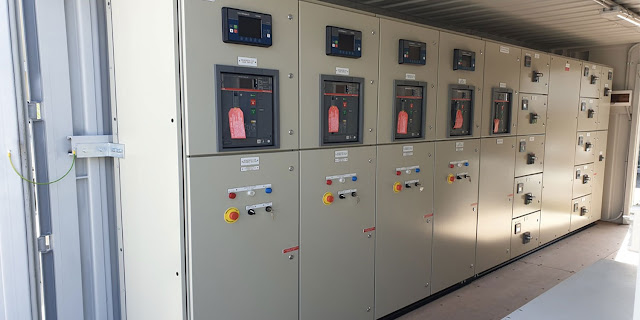Different Methods and Procedures in Calculating Short Circuit Currents
A short circuit is an abnormal condition where there is a direct connection between two or more conductors, or between conductors to the ground. In this case, it causes a very high current to flow through the conductors that can sustain extensive damage to electrical equipment. To obtain reliable, coordinated operation and assure that system components are protected from damage, it is necessary to first calculate the available fault current at various critical points in the electrical system.
Related Article: Short Circuit Calculation by Impedance Method
Once the short-circuit levels are determined, the engineer can specify proper interrupting rating requirements, selectively coordinate the system and provide component protection. Not only should the protection measures for an electrical system be safe for all service conditions, but they must also be selectively coordinated to ensure continuity of service.
 |
| Figure 1. Total AC and DC Component of Short Circuit Current |
Sources of Short Circuit Currents
- Utility Generation - Short circuit current can originate from the utility power source, which can be caused by faults from the power generation. This can result in a large amount of current flowing into the electrical power system, causing extensive damage to equipment and posing a safety risk to personnel.
- Local Generators - Local generation sources, such as diesel generators can also be sources of short circuit current.
- Transformers - Transformers are often spoken of as a source of short-circuit current. Strictly speaking, this is not correct, for the transformer merely delivers the short-circuit current generated by generators or motors ahead of the transformer. Transformers merely change the system voltage and magnitude of current but generate neither. The short-circuit current delivered by a transformer is determined by its secondary voltage rating and reactance, the reactance of the generators and system to the terminals of the transformer, and the reactance of the circuit from the transformer to the short circuit.
- Synchronous Motors - Synchronous motors are used in many industrial applications, and they can be sources of short circuit current during fault conditions. The short circuit current from synchronous motors is usually of high magnitude and can be challenging to protect against.
- Induction Motors - Induction motors are another common source of short circuit current, and their characteristics during fault conditions depend on the type and location of the fault. The short circuit current from induction motors is usually of moderate magnitude and can be easier to protect against compared to synchronous motors.
Different Methods of Short Circuit Calculation
There are different methods for short circuit protection, including the per-unit method, the point-to-point method, and the impedance method. Each method has its own characteristics, advantages, and limitations.
- Per-Unit Method - The per-unit method is a commonly used method for short circuit protection. This method is based on expressing the system parameters in per-unit values, which are normalized to a base value, such as the rated voltage or the rated MVA of the system. Short circuit calculations are then performed using these normalized values, and protective devices such as circuit breakers are selected based on their ratings in per-unit values. The per-unit method is simple, efficient, and allows for easy coordination of protective devices, as the per-unit values are independent of the absolute values of the system parameters.
- Point-to-Point Method - The point-to-point method involves calculating the impedance of the system between the fault location and the source. The fault current is then calculated using Ohm's Law by dividing the voltage at the source by the impedance of the system. Protective devices are selected based on the fault current and the time-current characteristics of the protective device. The point-to-point method is more accurate than the per-unit method, as it considers the actual values of the system parameters, but it is more complex and requires detailed information about the system.
- Ohmic Method - The ohmic method is another method used for short circuit protection in electrical power systems. This method is based on calculating the impedance of the equipment that is being protected, such as transformers, generators, or cables. The impedance is then used to calculate the maximum fault current that can flow through the equipment, and protective devices such as fuses, or circuit breakers are selected based on this maximum fault current.
The Use of Computer Software in Calculating Short Circuit Currents
- Speed and Efficiency - Short circuit calculations can be complex and time-consuming, especially for large and complex systems. Computer software can perform these calculations quickly and efficiently, saving time and effort compared to manual calculations.
- Accuracy - Computer software uses mathematical algorithms to perform short circuit calculations, which can improve the accuracy and reliability of the results. This can help to ensure that protective devices are properly selected and coordinated, and that equipment is protected from damage.
- Flexibility - Computer software can handle different types of short circuit calculations, such as three-phase faults, single-phase-to-ground faults, and line-to-line faults, and can accommodate different system configurations and fault conditions. This flexibility allows engineers and technicians to explore different scenarios and optimize the protection settings.
- Visualization - Many short circuit calculation software programs provide visualization tools, such as one-line diagrams, fault current plots, and protection device coordination curves. These tools can help engineers and technicians to better understand the system behavior and to identify potential problems.
- Documentation - Computer software can generate reports and documentation of the short circuit calculations, including the system data, the calculation results, and the protective device settings. This documentation can be used for record-keeping, compliance, and future reference.
View or Download PDF
- Title: A Simple Approach to Short Circuit Calculations
- Source: Cooper Bussman


.webp)











No comments: